Italian actor Bruto Castellani (1881 - 1933) was the Arnold Schwarzenegger of the silent era. He was the noble strong man in such historical epics as Quo Vadis? (1913) and (1924), and Gli ultimi giorni di Pompei/The Last Days of Pompeii (1926).
![Bruto Castellani in Quo vadis?]()
Italian postcard by Ed. A. Traldi, Milano, no. 665. Photo: publicity still for Quo Vadis? (1924, Gabriellino D'Annunzio, Georg Jacoby), produced by the Unione Cinematografica Italiana.
Good Giant
Bruto Castellani was born in Rome in 1881. Het started with small parts in silent films for the Cines company like the historical drama Santa Cecilia/Saint Cecilia (1911, Enrique Santos). He had his breakthrough as the noble strong man Ursus in the historical drama Quo Vadis? (1913, Enrico Guazzoni). This story of the persecution of the Christians by the Emperor Nero was based on the novel by Henryk Sienkiewicz. At the London gala premiere in the Albert Hall, the king and queen congratulated Castellani with his performance. He next performed as the good giant in such epic films as Cajus Julius Caesar/Julius Caesar (1914, Enrico Guazzoni) starring Amleto Novelli, Fabiola (1918, Enrico Guazzoni) with Elena Sangro, Messalina/The Fall of an Empress (1923, Enrico Guazzoni), the 1924 version of Quo Vadis? (1924, Gabriellino D'Annunzio, Georg Jacoby) with Emil Jannings as Nero, and the 1926 version of Gli ultimi giorni di Pompei/The Last Days of Pompeii (1926, Carmine Gallone, Amleto Palermi).
![Quo vadis?]()
Italian postcard by Uff. Rev. St. Terni. Photo: Film Cines, Roma. Publicity still for Quo Vadis? (1913, Enrico Guazzoni). Helped by Acte, Nero's former mistress, Ursus (Bruto Castellani) subtracts Lygia (Lea Giunchi) from the orgy of the imperial banquet, where the drunken Roman Vinicius tried to rape her.
![Bruto Castellani and Augusto Mastripietri in Quo vadis? (1913)]()
Italian postcard by Uff. Rev. St. Terni. Photo: Film Cines, Roma. Publicity still for Quo Vadis? (1913, Enrico Guazzoni). Christian strong man Ursus (Bruto Castellani) orders the treacherous Greek philosopher Chilon (Augusto Mastripietri) to come along.
![Quo vadis?]()
Italian postcard by Uff. Rev. St. Terni. Photo: Film Cines, Roma. Publicity still for Quo Vadis? (1913, Enrico Guazzoni). Vinicius (Amleto Novelli) finds back Lygia at the catacombs of Ostriano. Left of Lygia is St. Peter (Giovanni Gizzi), right of her protector Ursus. Vinicius plots to abduct Lygia, with the help of the Greek Chilo (Augusto Mastripietri) and a gladiator.
![Quo vadis?]()
Italian postcard by Uff. Rev. St. Terni. Photo: Film Cines, Roma. Publicity still for Quo Vadis? (1913, Enrico Guazzoni). Lygia saves Vinicius from the hands of Ursus (Bruto Castellani). Ursus, protector of Lygia, has just killed a gladiator who had been charged by Vinicius to kill Ursus while he himself planned to abduct Licia.
![Quo vadis?]()
Italian postcard by Uff. Rev. St. Terni. Photo: Film Cines, Roma. Publicity still for Quo Vadis? (1913, Enrico Guazzoni). The Giant Ursus awaits the bull in the circus. After his long captivity Ursus is almost blinded when he enters the arena. Then a wild bull enters the arena on which back Lygia is bound. Ursus will kill the bull with his bare hands, much to the Delight of the audience and the emperor.
![Quo vadis?]()
Italian postcard by Uff. Rev. St. Terni. Photo: Film Cines, Roma. Publicity still for Quo Vadis? (1913, Enrico Guazzoni). Ursus and Vinicius implore the audience and emperor Nero to grace the Christian Lygia, after Ursus has killed the bull on which back Lygia had been bound. The audience raves because of Ursus' tour de force. Vinicius has stripped his cloth to show his scars from the wars, while Ursus holds up Lygia. All around Nero hold their thumbs up for grace, even if this sign seems to have been a 19th century invention and historically incorrect.
Bad Pirate
Bruto Castellani performed as well in adventure films set in modern times. His rival strong man Bartolomeo Pagano had done the same after his success as Maciste in Cabiria (1914). Catellani appeared in 'modern' films like Una tragedia al cinematografo/Cinema Tragedy at Carnival Time (1913, Enrico Guazzoni) and Il misteri del castello di Monroe/The Secret of Monroe Castle (1914, Augusto Genina), both starring diva Pina Menichelli. Next to good guys, Castellani played one memorable baddy: the pirate Gothar in the naval battle scene in Ben-Hur: A Tale of the Christ (1925, Fred Niblo), shot near Livorno in 1924. His last film was La bella corsara/The Beautiful Corsair (1928, Wladimiro De Liguoro) featuring Rina De Liguoro. In 1928, Castellani withdrew from the cinema and became a civil servant. Bruto Castellani died in 1933 in Rome.
![Emil Jannings as Nero]()
Emil Jannings as Nero in Quo Vadis? (1924). Italian postcard Ed. A. Traldi, Milano, no. 668. Photo: Unione Cinematografica Italiana. On the backside is an ink stamp for the Politeama Cesare Rossi, Fano.
![Elena Sangro in Quo vadis]()
Elena Sangro as Empress Poppea in Quo Vadis? (1924). Italian postcard by Ed. A. Traldi, Milano, no. 663. Photo: Unione Cinematografica Italiana.
Sources: Vittorio Martinelli (Maciste & Co. I giganti buoni del muto italiano) and IMDb
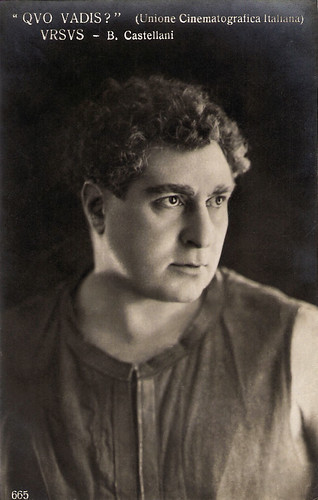
Italian postcard by Ed. A. Traldi, Milano, no. 665. Photo: publicity still for Quo Vadis? (1924, Gabriellino D'Annunzio, Georg Jacoby), produced by the Unione Cinematografica Italiana.
Good Giant
Bruto Castellani was born in Rome in 1881. Het started with small parts in silent films for the Cines company like the historical drama Santa Cecilia/Saint Cecilia (1911, Enrique Santos). He had his breakthrough as the noble strong man Ursus in the historical drama Quo Vadis? (1913, Enrico Guazzoni). This story of the persecution of the Christians by the Emperor Nero was based on the novel by Henryk Sienkiewicz. At the London gala premiere in the Albert Hall, the king and queen congratulated Castellani with his performance. He next performed as the good giant in such epic films as Cajus Julius Caesar/Julius Caesar (1914, Enrico Guazzoni) starring Amleto Novelli, Fabiola (1918, Enrico Guazzoni) with Elena Sangro, Messalina/The Fall of an Empress (1923, Enrico Guazzoni), the 1924 version of Quo Vadis? (1924, Gabriellino D'Annunzio, Georg Jacoby) with Emil Jannings as Nero, and the 1926 version of Gli ultimi giorni di Pompei/The Last Days of Pompeii (1926, Carmine Gallone, Amleto Palermi).

Italian postcard by Uff. Rev. St. Terni. Photo: Film Cines, Roma. Publicity still for Quo Vadis? (1913, Enrico Guazzoni). Helped by Acte, Nero's former mistress, Ursus (Bruto Castellani) subtracts Lygia (Lea Giunchi) from the orgy of the imperial banquet, where the drunken Roman Vinicius tried to rape her.
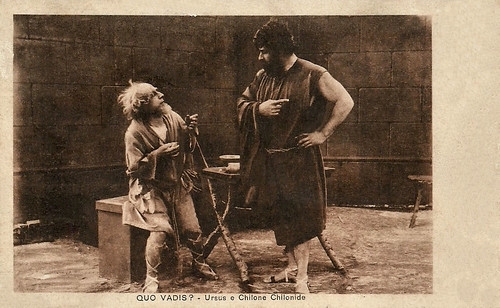
Italian postcard by Uff. Rev. St. Terni. Photo: Film Cines, Roma. Publicity still for Quo Vadis? (1913, Enrico Guazzoni). Christian strong man Ursus (Bruto Castellani) orders the treacherous Greek philosopher Chilon (Augusto Mastripietri) to come along.
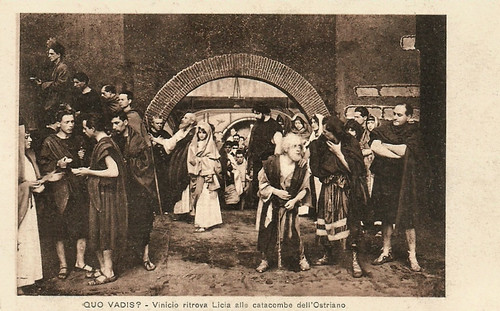
Italian postcard by Uff. Rev. St. Terni. Photo: Film Cines, Roma. Publicity still for Quo Vadis? (1913, Enrico Guazzoni). Vinicius (Amleto Novelli) finds back Lygia at the catacombs of Ostriano. Left of Lygia is St. Peter (Giovanni Gizzi), right of her protector Ursus. Vinicius plots to abduct Lygia, with the help of the Greek Chilo (Augusto Mastripietri) and a gladiator.
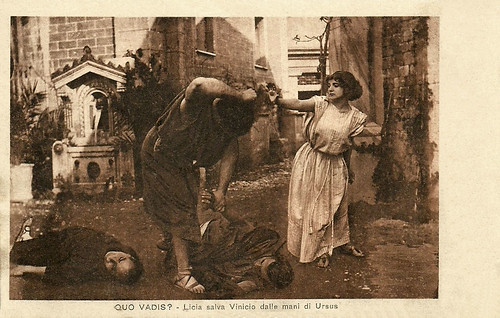
Italian postcard by Uff. Rev. St. Terni. Photo: Film Cines, Roma. Publicity still for Quo Vadis? (1913, Enrico Guazzoni). Lygia saves Vinicius from the hands of Ursus (Bruto Castellani). Ursus, protector of Lygia, has just killed a gladiator who had been charged by Vinicius to kill Ursus while he himself planned to abduct Licia.

Italian postcard by Uff. Rev. St. Terni. Photo: Film Cines, Roma. Publicity still for Quo Vadis? (1913, Enrico Guazzoni). The Giant Ursus awaits the bull in the circus. After his long captivity Ursus is almost blinded when he enters the arena. Then a wild bull enters the arena on which back Lygia is bound. Ursus will kill the bull with his bare hands, much to the Delight of the audience and the emperor.
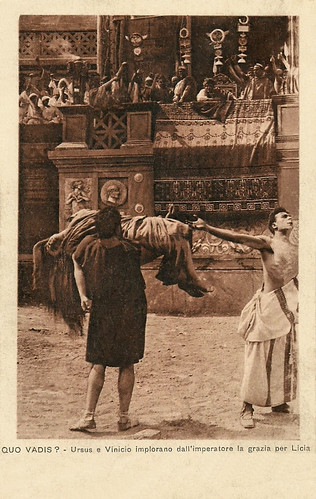
Italian postcard by Uff. Rev. St. Terni. Photo: Film Cines, Roma. Publicity still for Quo Vadis? (1913, Enrico Guazzoni). Ursus and Vinicius implore the audience and emperor Nero to grace the Christian Lygia, after Ursus has killed the bull on which back Lygia had been bound. The audience raves because of Ursus' tour de force. Vinicius has stripped his cloth to show his scars from the wars, while Ursus holds up Lygia. All around Nero hold their thumbs up for grace, even if this sign seems to have been a 19th century invention and historically incorrect.
Bad Pirate
Bruto Castellani performed as well in adventure films set in modern times. His rival strong man Bartolomeo Pagano had done the same after his success as Maciste in Cabiria (1914). Catellani appeared in 'modern' films like Una tragedia al cinematografo/Cinema Tragedy at Carnival Time (1913, Enrico Guazzoni) and Il misteri del castello di Monroe/The Secret of Monroe Castle (1914, Augusto Genina), both starring diva Pina Menichelli. Next to good guys, Castellani played one memorable baddy: the pirate Gothar in the naval battle scene in Ben-Hur: A Tale of the Christ (1925, Fred Niblo), shot near Livorno in 1924. His last film was La bella corsara/The Beautiful Corsair (1928, Wladimiro De Liguoro) featuring Rina De Liguoro. In 1928, Castellani withdrew from the cinema and became a civil servant. Bruto Castellani died in 1933 in Rome.

Emil Jannings as Nero in Quo Vadis? (1924). Italian postcard Ed. A. Traldi, Milano, no. 668. Photo: Unione Cinematografica Italiana. On the backside is an ink stamp for the Politeama Cesare Rossi, Fano.

Elena Sangro as Empress Poppea in Quo Vadis? (1924). Italian postcard by Ed. A. Traldi, Milano, no. 663. Photo: Unione Cinematografica Italiana.
Sources: Vittorio Martinelli (Maciste & Co. I giganti buoni del muto italiano) and IMDb